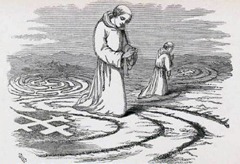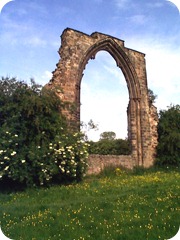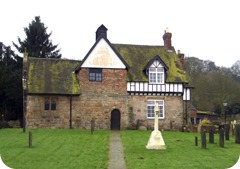 There can be no doubt that a hermitage existed on the site of St Ann’s Well since it is mentioned in the Nottingham Corporation records dating from 1513, which refer to ‘Le Hermitage,’ ‘Hermitage Wong’, and ‘Hermitage Close.’ Hermitages were small sites where one or more hermits went to find peace in remote places. Access to hermitages would be limited - physically, e.g. by their remoteness, or socially, e.g. in private places. They were simple sites usually with a small house and simple chapel often built by the hermit them selves. Wealthy patrons could endow hermitages, as at Warkworth, Northumberland.
There can be no doubt that a hermitage existed on the site of St Ann’s Well since it is mentioned in the Nottingham Corporation records dating from 1513, which refer to ‘Le Hermitage,’ ‘Hermitage Wong’, and ‘Hermitage Close.’ Hermitages were small sites where one or more hermits went to find peace in remote places. Access to hermitages would be limited - physically, e.g. by their remoteness, or socially, e.g. in private places. They were simple sites usually with a small house and simple chapel often built by the hermit them selves. Wealthy patrons could endow hermitages, as at Warkworth, Northumberland.
It consisted of a single building attached to one side of a farmhouse on the same site. The farm being the means that made the hermits here self-sufficient in food from the land, supplemented with the meat from farm animals. The location of the hermitage here was entirely due to the spring of the Beck that trickled up out of the ground, and flowed down the hill of the Beck valley.
St Ann’s holy well was important since it was a valuable attraction for pilgrims and visitors, who gave gifts of money or other valuables to the hermits, and brought food and ale for themselves. The greatest attraction being on St Ann’s Day itself, which is 26 July at the height of the British Summer.


 I remember visiting Dale Abbey that was also the site of a hermitage. Dale Abbey is situated three miles South West of Ilkeston off the A6096 road, six miles North East of Derby. Once known as Depedale this tranquil little village contains a tiny church, a pub, a school and the remains of an abbey founded here by Augustinian monks in the 13th century.
I remember visiting Dale Abbey that was also the site of a hermitage. Dale Abbey is situated three miles South West of Ilkeston off the A6096 road, six miles North East of Derby. Once known as Depedale this tranquil little village contains a tiny church, a pub, a school and the remains of an abbey founded here by Augustinian monks in the 13th century.
The curious little church of All Saint's, measuring just 26 feet by 25 feet, probably one of the smallest in the country, shares a roof with an adjoining farmhouse. The church dates back originally to the mid 12th century,  altered in 1480, to give it its present form.
altered in 1480, to give it its present form.
It contains a pulpit that dates from 1634 and the whole interior appears rather crammed with its box pews and open benches. The farmhouse was once possibly used as an infirmary for the Abbey. For some time before 1820 it was used as a pub called the Blue Bell, the bar being used as a vestry, with a door into the aisle. It was rebuilt in 1883.
The small church at Dale Abbey which shares its roof with the farm house, is some what similar to the set up at St Ann’s Well itself, were the hermitage is attached to one side of the farm house. However, the hermitage at St Ann’s Well is a little different to others since there were frequent visitors by Nottingham town’s folk to the well, and secondly the site is located in The Coppice which is the King’s domain, that was frequently used for hunting deer and wild bore.
In the 16th century, the farmhouse would have no running water so constructing the building next to a cold-water stream percolating up out of the ground was the best solution, and to have this ‘well’ in a lean-to shed with access from inside the farmhouse itself was even better. 19th century paintings of the farm show a small building next to the farmhouse itself which houses St Ann’s Well almost certainly paid for by Nottingham town elders to protect themselves, and town people from the elements, and spare their blushers, however, originally their may not have been such an elaborate structure.
In the 16th century, straw was a valuable material; it was used to thatch the roof of the farmhouse, and out buildings, and quite possibly the hermitage itself. Straw was used to make manure during the daily task of cleaning out the cowshed, pigs and stables.
It was also used as a building material. The walls of a farm building were first weaved from relatively straight wooden branches obtained by the Woodward who had the job of coppicing the nearby woodland. Sturdy wooden poles were hammered firmly into the ground, and then the thinner branches were weaved in and out to form the wall. The process was completed on all four sides leaving a space for the main doorway. Straw, cow or horse dung, and lime were mixed together to form a white daubing mixture that was applied thickly by hand, and pushed into all the cracks.
For larger buildings like the farmhouse or farmyard sheds, tree trunks were used, which were axed and worked into long beams. Simple mortise & tenant joints were cut and fitted together. A hole was drilled through the side of each joint, so when the two pieces were fitted together, a wooden beg hammered through the holes held each joint firmly in place.
Straw was also used to make rope; hand full of straw were pushed together lengthways, and then twisted. Once a good length was achieved, one end was bent round forming a loop, which then went onto a iron hook attached to a building, or quite often, the hook was attached to a wooden hand held handle. It was then a matter of adding further hands full of straw, and twisting the rope until the desired length had been achieved, at this point each end was tied firmly with a piece of linen string. Straw rope was useful in thatching the roofs of buildings, and around the farm.
It was also used to make the beds of the farm labourers. In the sixteenth century farmhouse, those that were considered wealthy used luxurious eiderdown, or feather stuffed mattresses, others would have flock or wool, and those who were servants made use of straw. Man size straw filled sacks had to be changed every eight to twelve weeks because they tended to become smelly and attracted bed mites and small insects. In an effort to prevent this, herbs were used to keep the insects at bay, and keep the straw mattress reasonably fresh.
The floor of the farmhouse was originally the hardened clay soil base where the building was constructed, although in the 19th century this was brick laid.
The chimneystack was quite large at the base to allow for a good-sized fireplace indoors for cooking with various size vessels of iron or pottery. Inside the chimneybreast was two or three iron bars part way up the chimney, used for smoking hanks of pork, veal, venison, or fish. Such cured meats would stay fresh to eat for many weeks after being treated in this way. The fireplace was used for baking bread, and boiling the water ready to make ale or mead, which every member of the household drank because it was far less likely to cause illness, even fresh water from St Ann’s Well had to be boiled before it could be drank, except when the thirst was so great it was drunk neat with cupped hands or beaker with a certain amount of risk involved.
When spring cleaning came around, the straw beds had to be emptied and re-stuffed, and textiles used for covering tables or beds, had to be hung over a line and beaten to get rid of the accumulated dust of the previous season. In these early times, the available textiles were made from homespun wool, linen, or hemp.
Cleaning the big chimney was a big job involving three or four men, and they used a number of branches of prickly holly all tied together. This bush was tied with a long rope that was dropped down the chimney inside the fireplace. At the bottom, two men pulled on the rope to drag the holly bush down the chimney cleaning all of the soot along the way. Sometimes the holly became stuck on the iron bars inside the chimneybreast, and a man had to stand up inside the chimney to free the bush. Understandably, it was a messy, dusty business. Afterwards, the inside of the farmhouse had to be swept clean using a broom, which was also used to sweep the crevices of the white interior walls.
The main table, stools and trestles were all made out of wood collected locally, even the soup bowls, and candles provided the lighting. In later years, whale oil lamps replaced the candles.
At St Ann’s well the farmhouse had, an upper floor either reached by an angled wooden ladder or constructed stairs, to reach the part of the house used as the sleeping quarters. As the decades passed their were many improvements to make things easier, and the farmhouse and its rooms more comfortable.
In time, the hermitage became derelict through the lack of maintenance, and disrepair, as the people living here became much more involved in farming the land, brewing ale, and receiving visitors to the holy well that had grown in popularity. It was demolished sometime in the mid fifteenth century around the time of the dissolution of the monasteries through out the country. Although the hermitage here was by no means a monastery, it was originally built as a religious retreat, it therefore fell into disfavour, and its useful purpose declined.
However, as a working farm and holy spring latterly run by a Mrs. Blee, business was doing really well. Although we don’t know what animals the farm had, I think it likely that pigs, one or two dairy cows, chickens, and geese were here providing the meat, and produce making the household self sufficient. The Woodward was responsible for coppicing the nearby woodland of mainly horse chestnut, and oak trees. Most probably charcoal making on a small scale, which can be used as a smokeless fuel for indoor cooking.
Mrs. Blee’s farm at St Ann’s Well was not the only local farm in the area, another was Rose hill farm on Beacon Hill situated at the top of what is now St Matthias Road; at the time of Blee’s farm this was a cart track, as was Beacon hill rise that also ran through Rose hill farm. The Beck valley of course was another cart track than ran from the town of Nottingham up to St Ann’s well and the coppice woodland. Today the Wells Road is lined either side with horse chestnut trees, some of which are over two centuries old; these trees were plentiful in The Coppice near Blee’s farm.
In the past, Horse-chestnut seeds were used for whitening hemp, flax, silk, and wool. They contain a soapy juice, fit for washing of linens and stuffs, for milling of caps and stockings, etc., and for fulling of cloth. For this, 20 horse chestnuts were sufficient for six litres of water. They were peeled, then rasped or dried, and ground in malt or other mill. The water must be soft, either rain or river water. The nuts are then steeped in cold water, which soon becomes frothy, as with soap, and then turns white as milk. It must be stirred well at first, and then, after standing to settle, strained or poured off clear. Linen washed in this liquid, and afterwards rinsed in clear running water, takes on an agreeable light sky-blue colour. It takes spots out of both linen and woollen, and never damages or injures the cloth. Horse chestnuts were also used to make a form of starch for stiffening cloth.
Farming the land was certainly hard work for the farmhands who did not have the benefit of early tractors, and machinery to make life easy; it was hard backbreaking work.
At St Ann’s well the farmland stretched across the present well’s Road, and covered much of the appropriately named Wells Gardens nearby. The land was often difficult to dig and cultivate because of the many woody fibrous roots in the hard baked ground. The first task was to use stones found lying around, and willow to mat together, and construct a perimeter fence around the land, so that farm animals could not escape, especially pigs.
Pigs in the 18th century were a valuable asset, not only for their bacon but because they forage for their food digging into the ground for the roots, and vines. Therefore, by putting pigs into the enclosure to be cultivated for about a month, they did much of the hard work. After returning the pigs to their farmyard pens, farmhands could then cut and pull up much of what was left, piling the woody roots into small bonfires around the enclosures. These pyres were then lit and left to burn, smouldering away for a number of days. The red, and brown, powdering residue being rich in phosphates, it was then spread across the worked ground.


It is important to mention that up until the Middle Ages of the 16th century Paganism played a part in worship practices at St Ann’s Well. Paganism is the broad term used to describe any religion or belief that is not Christian, Jewish or Muslim. Paganism can be traced back to Neolithic times and survived up until the middle ages when Christianity became powerful enough to erase it from existence. Paganism is an earth based religion which lays emphasis on the worship of all aspects of nature. Paganism appeared very early on in the history of the world. Examples of early paganism can be seen in ancient Greek and Roman religions, as well as in ancient Goddess worship and Druidic religions.
Ancient people believed that everything had a spirit and were polytheistic and they placed great importance on the worship of many Gods, Goddesses and Deities. Gods were a part of everyday life and great emphasis was placed on placating them through worship and ritual. Pagans believed that the Gods were immanent and entered every aspect of their society, influencing everything from laws and customs to the general workings of their community.
In the few short years that Blee’s farm was the first pub in St Ann’s, pagan beliefs caused rows & brawls inside, and outside, the premises, that led to the premises losing its victualler's license.
Since St Ann’s well was principally a farm the Lacnunga chant composed in 1050 may have been used once the land had been prepared and sown with crops, along with a charm for increasing the fertility of the fields, known as the Acerbate. It contains a pagan hymn to the sun and another to the earth. Both contain details of the ritual—
Turn to the east and bowing humbly nine times, saying these words:
'Eastwards I stand, for favours pray
I pray to the great Lord, I pray to the mighty Prince.'
Then turn three times sun wise and stretch yourself along the ground full length.
The hymn to the earth included a ceremony that continued well into Christian times, the ceremony of burying a cake with the first ploughed earth. Take every kind of meal and have a loaf baked no bigger than the palm of your hand, having kneaded it with milk and holy water, and lay it under the first turned furrow. The hermitage here would have been the ideal place to obtain holy water for the yearly ceremony.
Say these words:
'Erce, Erce, Erce, Mother of Earth,
Hail to thee, Earth, mother of men,
Be fruitful in God's embrace,
Filled with food for the use of men.'
No comments:
Post a Comment